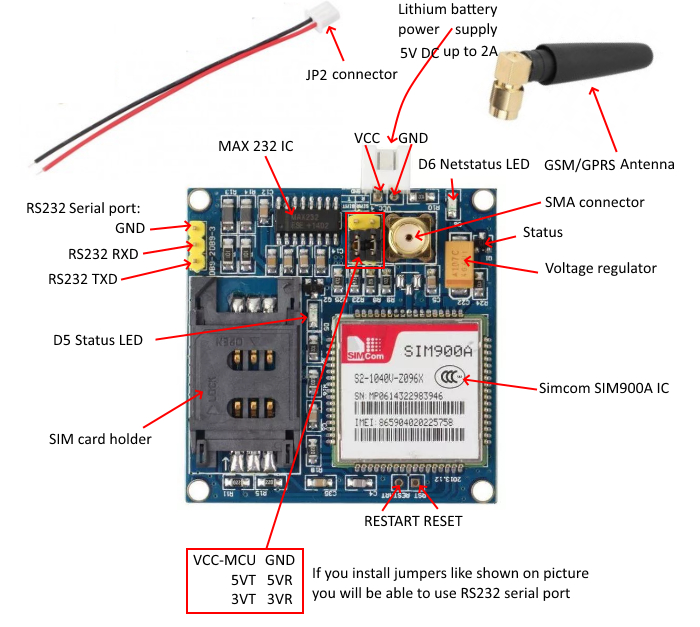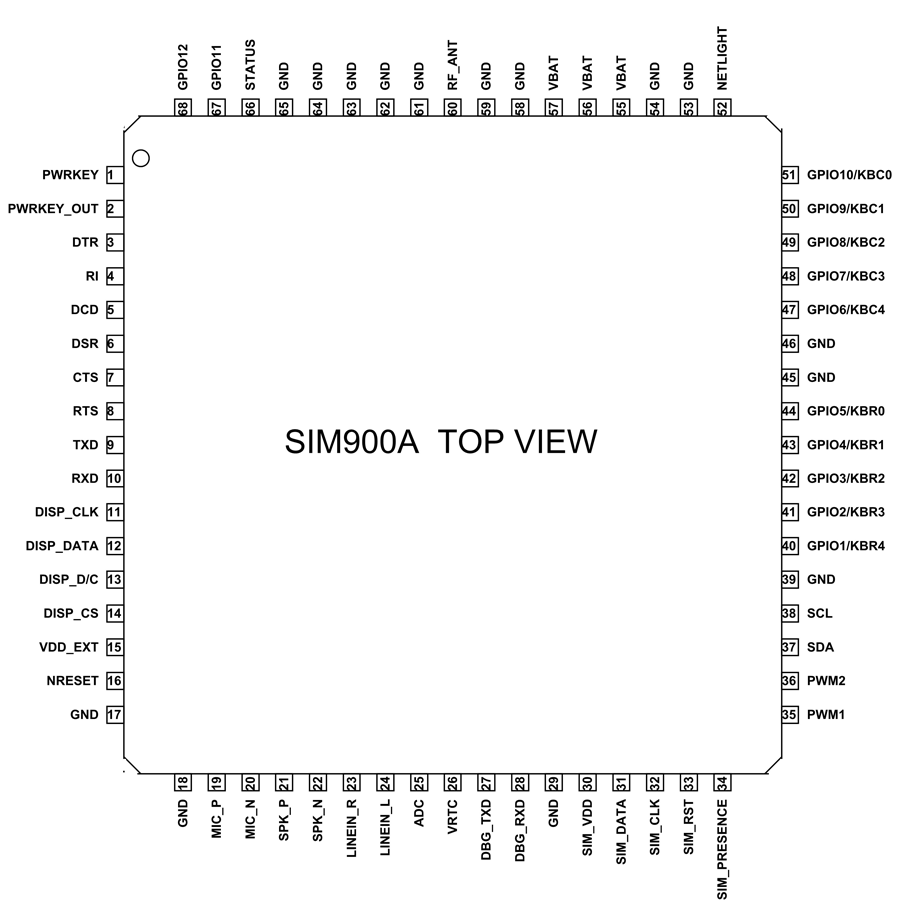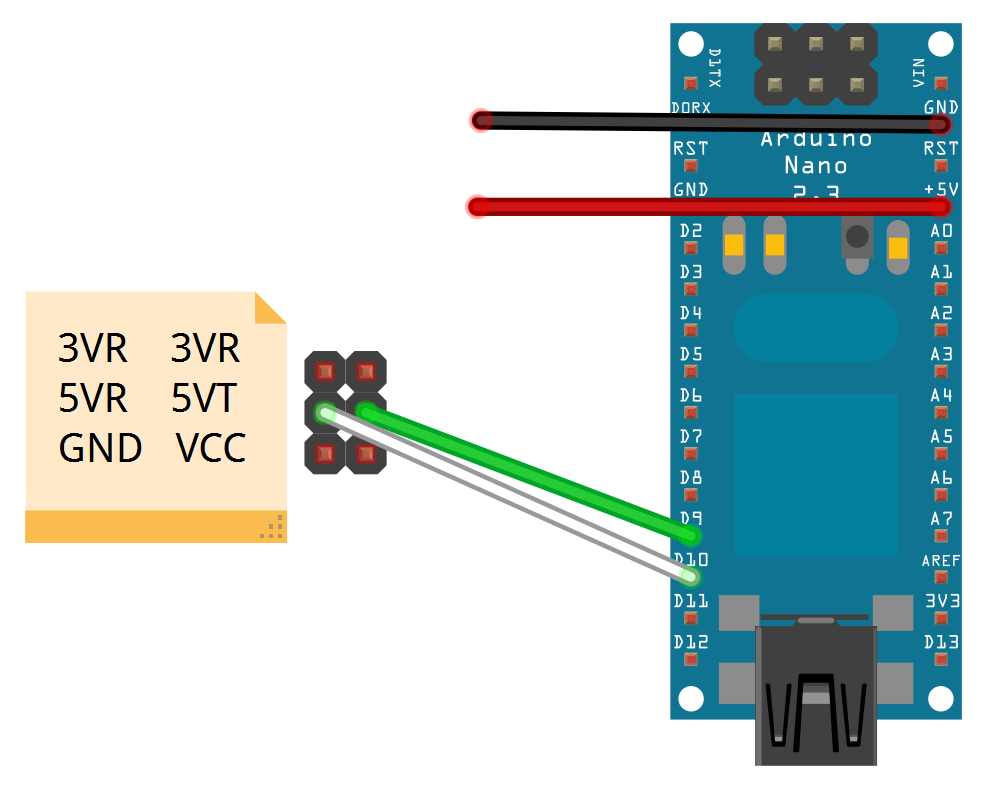SIM900A MINI (v3.8.2)
This SIM900/A V3.8.2 module has a set of TTL level serial interface, a set of RS232 level serial interface, a set of power supply interface.
Specifications
- Dual-Band 900/ 1800 MHz
- GPRS multi-slot class 10/8GPRS mobile station class B
- Compliant to GSM phase 2/2+
- Dimensions: 24243 mm
- Weight: 3.4g
- Control via AT commands (GSM 07.07, 07.05 and SIMCOM enhanced AT Commands)
- Supply voltage range : 5V
- Low power consumption: 1.5mA (sleep mode)
- Operation temperature: -40°C to +85 °


Firmware
AT+CPIN?
+CPIN: PH-NET PIN # SIM/device locked (carrier locked?)
While its great for Asian GSM infrastructure in different places in the world you will just get
PH-NET PINresponse meaning its locked for current network. I found that flashing SIM900A with firmware for SIM900 opens it up again to work exactly as SIM900, with slightly worse signal quality due to physical radio differences.
- Model: SIMCOM SIM900A (S2-1040V-Z1K0H) - likely region locked to CN
- Flash:
M58WR064KU, size: 64 Mb (?) - Firmware:
1137B12SIM900M64_ST
References:
- http://pixelatedpic.blogspot.com/2013/08/simcom-sim900a-fixed.html
- http://gauthierlerouzic.blogspot.com/2014/01/flash-sim900a-europe.html
- http://amichalec.net/2014/08/03/sim900a-fixed-for-europe/
Arduino example

#include <SoftwareSerial.h>
SoftwareSerial Modem(9, 10); // RX / TX
unsigned char buffer[64];
int count = 0;
void setup() {
Modem.begin(9600);
Serial.begin(9600);
Serial.print("Ready!");
}
void loop() {
if (Modem.available()) {
while (Modem.available()) {
buffer[count++] = Modem.read();
if (count == 64) break;
}
Serial.write(buffer, count);
clearBufferArray();
count = 0;
}
if (Serial.available())
Modem.write(Serial.read());
}
void clearBufferArray() {
for (int i = 0; i < count; i++) {
buffer[i] = NULL;
}
}
AT+CSQ
+CSQ: 21,0
OK
AT+COPS=?
+COPS: (1,"N NetCom","NetCom","24202"),(1,"N Telenor","TELENOR","24201"),,(0,1,4),(0,1,2)
OK
Using the TinyGSM library
#define TINY_GSM_MODEM_SIM900
#define SerialMon Serial
#define TINY_GSM_DEBUG SerialMon
#define PIN_MODEM_RX 9
#define PIN_MODEM_TX 10
//#define PIN_MODEM_RST 11
#define PIN_LCD_RST 2
#define PIN_LCD_CE 3
#define PIN_LCD_DC 4
#define PIN_LCD_DIN 5
#define PIN_LCD_CLK 6
#define PIN_LCD_BL 7
#define GSM_AUTOBAUD_MIN 9600
#define GSM_AUTOBAUD_MAX 57600
#define GSM_PIN ""
#define TARGET_PHONE "+47xxxxxxxx"
#include <TinyGsmClient.h>
#include <LCD5110_Graph.h>
#include <SoftwareSerial.h>
SoftwareSerial SerialAT(PIN_MODEM_RX, PIN_MODEM_TX); // RX, TX
LCD5110 screen(PIN_LCD_CLK, PIN_LCD_DIN, PIN_LCD_DC, PIN_LCD_RST, PIN_LCD_CE);
TinyGsm modem(SerialAT);
//extern uint8_t MediumNumbers[];
//extern uint8_t TinyFont[];
extern uint8_t SmallFont[];
void setup() {
// Set console baud rate
SerialMon.begin(115200);
delay(10);
DBG("Wait...");
pinMode(PIN_LCD_BL, OUTPUT);
screen.InitLCD();
screen.setFont(SmallFont);
screen.print("SIM:", 0, 0);
screen.print("OPR:", 0, 8);
screen.print("REG:", 0, 16);
screen.print("CSQ:", 0, 24);
screen.update();
delay(6000);
TinyGsmAutoBaud(SerialAT, GSM_AUTOBAUD_MIN, GSM_AUTOBAUD_MAX);
//delay(6000);
DBG("Initializing modem...");
modem.init();
delay(1000);
SimStatus simStatus = modem.getSimStatus();
screen.print(getSimStatusName(simStatus), 30, 0);
screen.update();
/*if (GSM_PIN && simStatus != 3) {
modem.simUnlock(GSM_PIN);
}
SimStatus simStatus = modem.getSimStatus();
screen.print(getSimStatusName(simStatus), 30, 0);
screen.update()*/
RegStatus regStatus = modem.getRegistrationStatus();
screen.print(getRegStatusName(regStatus), 30, 16);
screen.update();
String ccid = modem.getSimCCID();
DBG("CCID:", ccid);
String cop = modem.getOperator();
DBG("Operator:", cop);
screen.print(cop, 30, 8);
screen.update();
int csq = modem.getSignalQuality();
DBG("Signal quality:", csq);
screen.printNumI(csq, 30, 24);
screen.update();
//delay(1000);
//bool res = modem.sendSMS(TARGET_PHONE, String("Hello!"));
//DBG("SMS:", res ? "OK" : "fail");
/*bool res = modem.callNumber(TARGET_PHONE);
DBG("Call:", res ? "OK" : "fail");
delay(5000L);
if (res) {
delay(1000L);
// Play DTMF A, duration 1000ms
modem.dtmfSend('A', 1000);
// Play DTMF 0..4, default duration (100ms)
for (char tone = '0'; tone <= '4'; tone++) { modem.dtmfSend(tone); }
delay(5000);
res = modem.callHangup();
DBG("Hang up:", res ? "OK" : "fail");
}*/
// Enable Calling Line Identification Presentation
// modem.sendAT(GF("+CLIP=1"));
}
void loop() {
/*while (modem.stream.available()) {
String res = modem.stream.readStringUntil('\n');
//modem.waitResponse(1000L);
res.trim();
DBG(res);
if (res == "RING") {
DBG("INCOMING!");
}
else if(res == "NO CARRIER") {
DBG(":(");
}
}*/
}
String getRegStatusName(RegStatus status) {
switch (status) {
case 0: return "Unregistered";
case 1: return "Home";
case 2: return "Searching";
case 3: return "Denied";
case 4: return "Unknown";
case 5: return "Roaming";
default: return "No result";
}
}
String getSimStatusName(SimStatus status) {
switch (status) {
case 0: return "ERROR";
case 1: return "Ready";
case 2: return "Locked";
case 3: return "Antitheft";
}
}
References:
- https://github.com/vshymanskyy/TinyGSM
- https://github.com/erdemarslan/GSMSim
- https://www.instructables.com/GSM-SIM900A-With-Arduino/
AT Command Reference
AT+IPR - Set TE-TA Fixed Local Rate
Test: AT+IPR=? - Returns list of supported baud rates.
AT+IPR=?
+IPR: (),(0,1200,2400,4800,9600,19200,38400,57600,115200) # 0 = auto-bauding
SIM
AT+CSMINS - SIM Inserted Status Reporting
Test: AT+CSMINS=? (response OK)
Read: AT+CSMINS? - +CSMINS:<n>,<SIM inserted>
Write: AT+CSMINS=<n>
AT+CPIN - Enter PIN
Test: AT+CPIN=? (response OK)
Read: AT+CPIN? - Returns an alphanumeric string indicating whether some password is required or not.
Write: AT+CPIN=<pin>[,<new pin>]
AT+CPIN?
+CPIN: SIM PIN # MT is waiting SIM PIN to be given
Network/operator
AT+CSQ - Signal Quality Report
Returns received signal strength indication <rssi> and channel bit error rate <ber> from the ME.
Command: AT+CSQ
Response: +CSQ: <rssi>,<ber>
| Value | RSSI dBm | Condition |
|---|---|---|
| 2 | -109 | Marginal |
| 3 | -107 | Marginal |
| 4 | -105 | Marginal |
| 5 | -103 | Marginal |
| 6 | -101 | Marginal |
| 7 | -99 | Marginal |
| 8 | -97 | Marginal |
| 9 | -95 | Marginal |
| 10 | -93 | OK |
| 11 | -91 | OK |
| 12 | -89 | OK |
| 13 | -87 | OK |
| 14 | -85 | OK |
| 15 | -83 | Good |
| 16 | -81 | Good |
| 17 | -79 | Good |
| 18 | -77 | Good |
| 19 | -75 | Good |
| 20 | -73 | Excellent |
| 21 | -71 | Excellent |
| 22 | -69 | Excellent |
| 23 | -67 | Excellent |
| 24 | -65 | Excellent |
| 25 | -63 | Excellent |
| 26 | -61 | Excellent |
| 27 | -59 | Excellent |
| 28 | -57 | Excellent |
| 29 | -55 | Excellent |
| 30 | -53 | Excellent |
AT+COPS - Operator Selection
Test: AT+COPS=? - Returns list of operator present in the network
Read: AT+COPS? - Returns current mode and the currently selected operator
Write: AT+COPS=<mode>[,<format>,[<operator>]]
AT+COPS=?
+COPS: (2,"Telia N","","24202"),(1,"N Telenor","TELENOR","24201"),,(0,1,4),(0,1,2)
AT+CREG - Network Registration
Forces the mobile terminal to select and register the GSM/UMTS/EPS network.
Test: AT+CREG=? - Returns list of supported <n>s
Read: AT+CREG? - Returns result code and an integer (<stat>) which shows whether the network has currenctly indicated the registration of the ME
Write: AT+COPS=<mode>[,<format>,[<operator>]]
SMS
AT+CSCA - SMS Service Center Address
References: